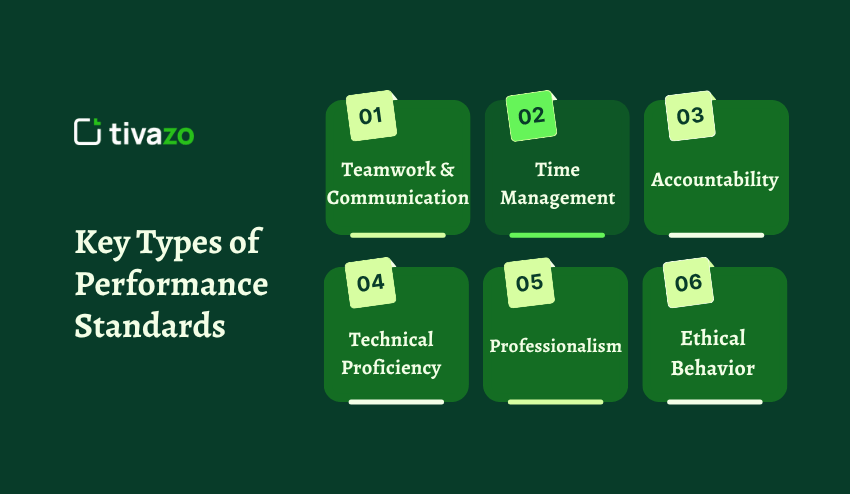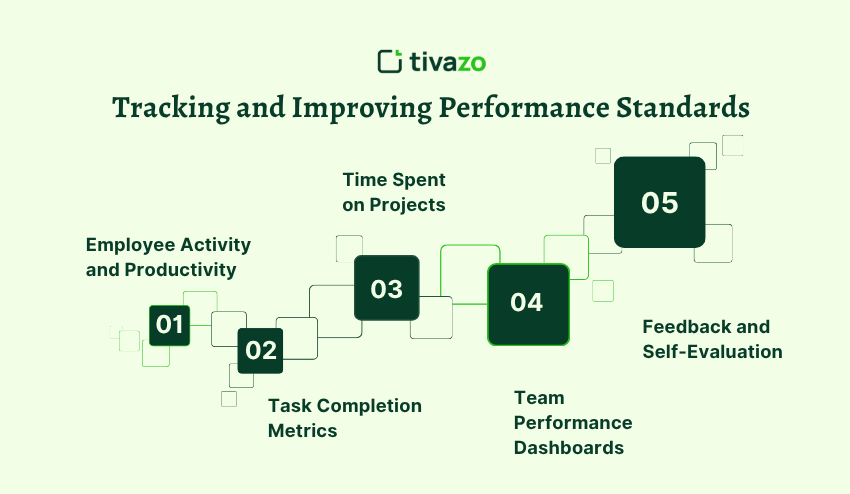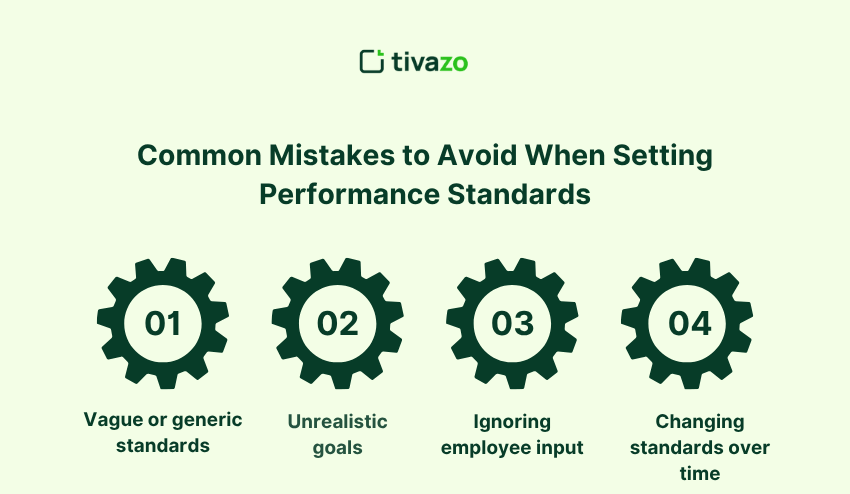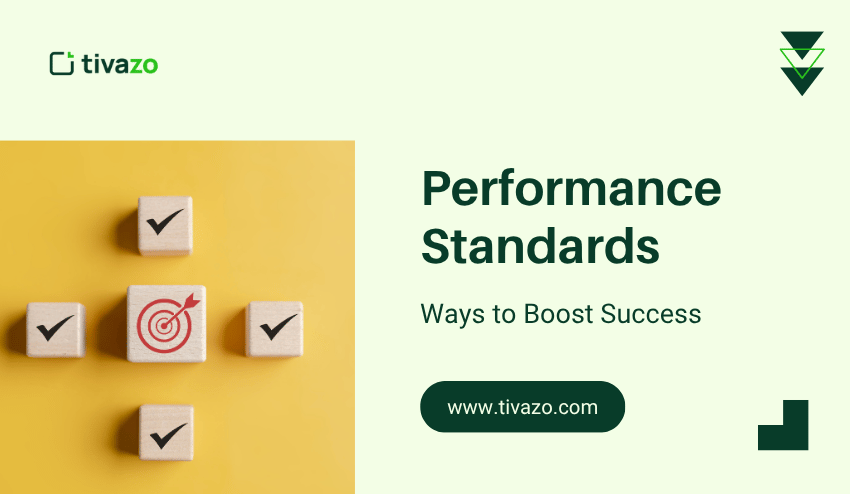In today’s business climate, simply hiring qualified employees is no longer sufficient for success. Performance standards also need to be created and established to set the basic foundation of expectations, responsibilities, and demonstrable outcomes that can be measured and achieved. Performance standards will not only line out the path to success for employees, but it will also allow the employee to stay in alignment with the company objectives and culture, thereby giving accountability to the team.
The companies that implement concrete performance standards both big and small often see a higher return on productivity, enhanced and clear communication, and engagement from their employees. This performance standards guide will outline what performance standards are, discuss why they are important, how to set performance standards, and finally how to utilize a tool such as Tivazo to help track and maximize your teams performance.
What Are Performance Standards?
Performance standards are a measurable yardstick to define quality work, quantity of work, and efficiency of work to be expected from employees. Performance standards give your hiring manager a standard form of measure that can be treated with consistency and fairness across all performance comparisons.
Examples of Performance Benchmarks may include:
- Quality of work
- Managing deadlines
- Communication skills
- Adherence to the policies of the company
Performance standards allow an organization to create concrete performance expectations in writing while removing static, setting performance goals for employees, and providing structure to a performance management system.
Why Performance Standards Matter for Businesses
Performance standards are important to organizations for several reasons:
- Clarity – Employees are well aware of what is expected from them.
- Fairness – Provides an objective criterion for the evaluation of team members.
- Motivation – Staff members are excited to work on increased productivity.
- Alignment – Personal goals are aligned to support the organization’s goals..
Without clear performance standards, teams may easily suffer from miscommunication, low productivity, or inconsistent results. When we have strong performance standards, we can be assured that every member’s efforts are aligned towards success.
Key Types of Performance Standards
Performance standards are key to clarifying expectations within the workplace. They help staff understand the expectations of their position, align their expectations to the organization’s goals, and develop continual improvement to performance. Although there may be some performance standards that are specific to various positions, there are a few core types of performance standards that are helpful to almost all employees. When an organization clearly defines these performance standard types, it will help with productivity and engagement, as well as increase accountability. The following types of performance standards are the best and are supplemented with examples of each.

1. Teamwork & Communication
Communication and collaboration and teamwork are at the center of effective operation. Employees should clearly communicate an idea, be able to listen attentively and work collaboratively with other associates across departments.
- Writing clear, concise emails: This helps to ensure the recipient is easily able to understand the email and it is less likely that the sender will be faced with follow-up questions. Well-written emails save time and reduce the likelihood of miscommunication.
- Practicing active listening: Allows employees to fully grasp instructions, feedback, and issues in order to collaborate better and make fewer errors.
- Collaborating across departments and with clients: Facilitates information sharing and problem-solving; strong collaboration ensures projects go smoothly and that the company achieves its goals efficiently.
2. Time Management
Time management standards help employees to prioritize their work, meet deadlines, and maintain their focus throughout the day. Effective time management promotes productivity and reduces stress.
- Prioritizing tasks effectively: Employees are able to first prioritize work that is time-sensitive or has a higher impact; important goals are completed without wasting time on tasks that weren’t as urgent.
- Meeting deadlines consistently: Employees show they are dependable and responsible. Whether it is working with a colleague, manager, or client, consistently meeting deadlines shows reliability.
- Minimizing distractions during work hours: Employees are able to maintain their focus, which promotes quality work completed in less time. Less distractions means the employee will be able to stay productive throughout their day.
3. Accountability
Accountability standards ensure employees hold themselves accountable for their decisions and outcomes to build trust and transparency.
- Owning assigned projects: Employees will fully own the success of completed tasks or projects, taking the responsibility for results; this will build confidence and initiative.
- Transparent reporting: Managers are always aware of progress or challenges employees are dealing with, and can offer timely assistance when employees need it.
- Taking responsibility for mistakes: This encourages learning instead of finger-pointing. Employees who take responsibility for their mistakes can see areas for improvement to proactively prevent mistakes in the future, allowing for growth and trust.
4. Technical Proficiency
Technical proficiency objectives help an employer to ensure employees are trained with the skills and knowledge necessary to perform their role and fulfill industry standards for compliance.
- Completing required certifications: This ensures employees are skilled and knowledgeable with the most current technology, supports quality of work, and fulfills compliance regulations or standards expected in the industry.
- Learning new skills or software: This helps you empower employees with an expanded skill set needed to evolve and stay competitive in an organizational environment that quickly changes. This creates opportunities for teams to competitively utilize new tools/software in the work environment.
- Following compliance standards: This ensures the task is performed legally, thus reducing risks or threats to the employer’s reputation.
5. Professionalism
Standards of professionalism create a respectful, disciplined, and productive work environment for all employees. The standards represent employee commitment to professionalism, and they have a positive impact in the workplace supporting employee teamwork and client relationships.
- Punctuality and meeting deadlines: Be someone colleagues can rely on, and consider other people’s time, which builds trust in the workplace and coordination.
- Respectful communication: Respectful communication promotes a positive work environment by limiting conflict and encouraging collaboration; when employees communicate respectfully, it promotes relationships among employees both internally and externally.
- Adhering to company policies: Consistency is important across the organization; when employees act according to company policies, it creates an atmosphere where the policy is clear and employees treat policies with respect.
6. Ethical Behavior & Service Excellence
A requirement for ethical behavior and service excellence is key to authenticity and trust, in addition to a successful outcome for the business, it’s an important aspect of client satisfaction. Employees should be assessed not solely this the outcomes, but how employees come to achieve the outcomes.
- Acting with integrity: Employees should function in honesty and fairness when making decisions; understands that actions are associated with the reputation of the company, and that builds trust among colleagues and clients.
- Providing high-quality customer service: Both satisfaction and loyalty will be positively impacted by addressing client needs in a timely and professional manner; a good client experience positively enhances brand image.
- Avoiding conflicts of interest: Prevents the undue influence of personal agendas upon one’s professional responsibilities, which allows professionals to maintain fairness, transparency, and impartiality in their decision-making.
How to Set Effective Performance Standards
Setting strong performance standards requires a structured and thoughtful approach. Clear standards ensure employees understand expectations, align their work with company goals, and are held accountable in a fair and measurable way. Below are the key steps to establish effective performance standards:
1. Review Job Descriptions
Before performance standards can be set, each role must be understood in detail. Responsibilities, day to day tasks, and deliverables should be ciritcally analyzed so that standards can be considered relevant. This prevents someone from setting an expectation that is unrealistic and allows for the employee to be assessed based on the job specificualtion rather than the literature typically associated with any role.
2. Identify Measurable Metrics
Operational outcomes shall be defined by some sort of metric to define what success looks like for both quantifiable and qualifiable indicators. Using Key Performance Indicators (KPI), or industry standards objectives to evaluate performance, ensures that managers can measure and define performance both fairly and consistently. Measurable metrics offer transparency and guarding against ambiguity.
3. Align with Company Objectives
All performance standards should support the larger goals of the organization. When employee expectations are aligned with the goals of the organization, the effort employees expend on their work supports the larger goals and strategic focus of the organization. The organization creates a sense of purpose and accountability.
4. Communicate Expectations Clearly
Employees can meet standards that they don’t understand. Each expectation, including the quality of work, quantity of work, deadlines, and behavior and conduct standards need to be clearly documented and communicated. The less confusion there is, the more accessible and clear expectations become, as well as employees’ confidence in meeting those expectations and goals.
5. Involve Employees
Employees should be included in the process to set standards. By soliciting their feedback, this will support buy-in, employee involvement guarantees the standards are even realistic, and this will also give employees ownership of their performance goals. Employees who are included in the establishment of standards are more engaged, more compliant.
6. Monitor and Review
Standards must be adaptive to business needs and performance patterns. Timely and regularly monitor outcomes, and KPIs, and review standards to determine areas for modification. Ongoing monitoring ensures the standards are relevant, provides motivation to improve, and continues to align with the organization’s goals.
Tracking and Improving Performance Standards
By monitoring an organizations’ performance will ensure that any performance standards in place are being adhered to and be improved on over time. Solutions like Tivazo has the capacity to supply key metrics to assist the manager in providing a comprehensive and effective strategy to manage standards over time.

- Employee Activity and Productivity: Find out how workers spend time/activities to direct focus/efficiency.
- Task Completion Metrics: Review contracts, quality, and consistent achievement of targets/deadlines to find bottlenecks and areas for improvement.
- Time Spent on Projects: Monitor hours spent working on a project to ensure the work is moving forward in a timely and efficient way without overwhelming the employee.
- Team Performance Dashboards: Centralized views for performance to inform specific team trends and committee progress, while also determining areas for needed follow up.
- Feedback and Self-Evaluation: Constructive feedback sessions to develop refinement for the existing goals and implementation of self-evaluation to increase feet-back and develop ownership for ongoing efforts.
These data-driven, quantifiable insights provide the manager with the ability to adjust, revise, and improve productivity while ensuring that performance standards are aligned with overall corporate goals.
Aligning Performance Standards with Company Goals
Performance standards, to be effective, can’t be developed in isolation — they must align directly to company objectives. When standards are aligned with company objectives, employees can be assured that what they’re doing in their role is contributing to measurable business success, they have accountability, and they have clarity on how their performance affects success at a bigger level. And employees are motivated intrinsically because they can see their work contributing to tangible business outcomes.
- Connect KPIs to revenue, customer satisfaction, or project success
- Engage employees in activities that drive measurable business outcomes
- Help ensure there is transparency among managers and team members
Common Mistakes to Avoid When Setting Performance Standards
Even with the best of intentions mistakes can occur when you set out to establish performance standards. Avoiding the mistakes will ensure that you establish performance standards that are unambiguous, fair, and motivational to the employee:

- Vague or generic standards: Performance standard that lack clarity could leave the employee unsure about what they need to do to perform well. When standards are specific and measurable they inform the employee what they need to do to perform well.
- Unrealistic goals: Goals that are unrealistic or too difficult for employees to reach can result in a lack of motivation for the employee to be productive. It’s imperative that goals be challenging but reachable.
- Ignoring employee input: Employees are a valuable source of information regarding what is practicable and/or reasonable regarding a task in their position. Not including their feedback can result in lack of engagement for the employee and unrealistic goals in some cases.
- Changing standards over time: The needs of the business, and/or the role of the employee, may change over time. Old standards may no longer mesh with their job or with the goals of the organization. Old standards may not produce the same results they once did..
Establishing your performance standards while being aware of these mistakes you can establish performance standards that are actionable, motivational, and aligned with organizational goals.
How Tivazo Helps You Maintain Strong Performance Standards
Having strong performance standards that are usable and actionable requires a system for ongoing monitoring and data-driven information. Tivazo gives managers the right tools to track productivity, analyze performance data, and help ensure company standards are being met. Managers have visibility to make better decisions, keep track of star performers, and solve issues before they start affecting outcomes.
- Track hours worked, task, and productivity
- Build reports and dashboards
- Ensure performance standards are actionable, measurable, and transparent
Tivazo provides the ability for managers to align employee output with company objectives, while providing the ability for employees to know what is expected and where improvement is needed.
Conclusion
Clearly defined performance standards empower employees, increase productivity, and allow employee contributions to systematically align toward company success. Companies can establish a culture of accountability, growth, and excellence by defining measurable expectations, tracking activity, and updating standards over time.
Get started on improving your team’s performance today with Tivazo’s analytics and time tracking capabilities.




